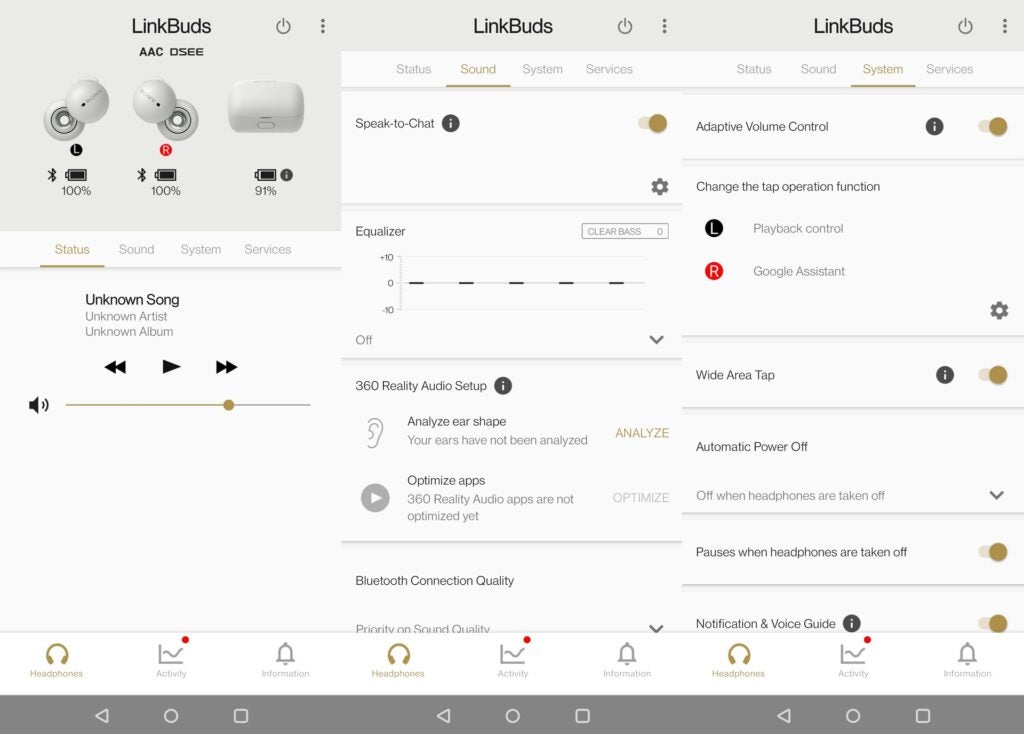Sony LinkBuds Review
A true wireless earphone unlike any you’ve seen before


Verdict
A fascinating pair of true wireless earphones that look like no earbud you’ve seen before. If convenience and awareness is what you want, the LinkBuds offer it in spades.
Pros
- Always open design
- Clear and spacious audio
- Features offer lots of convenience
- Wide Area Tap function is very cool
Cons
- Always open design
- Not the weightiest sounding pair
- Battery life may not be enough for some
Availability
- UKRRP: £149.00
- USARRP: $179.99
- EuropeRRP: €179.00
- CanadaRRP: CA$249.99
- AustraliaTBC
Key Features
- Wide Area TapCan detect vibrations on the cheek for operation
- 360 Reality AudioSupports 3D spatial audio tracks
- Adaptive Volume ControlRaises the volume automatically in accordance to external noises
Introduction
In a headphone market where there’s an emphasis on keeping the world at bay through noise-isolating designs, Sony’s LinkBuds go in a different direction.
Transparency modes that let the external world through have risen in popularity. The need for people to know what’s around them is a feature that headphone brands have made a concerted effort to bring to even their cheapest wireless earbuds. The LinkBuds are more novel in their execution in that they pursue an ‘open’ design that allows you to be always aware of your surroundings.
It’s not a new concept. Plenty of earphones from Apple’s AirPods to Urbanista’s Lisbon let the listener be aware of what is around them, but none have placed as much emphasis on awareness as Sony has with the LinkBuds. They impress, though like any other earphone that’s ‘open’, there are drawbacks of wanting to hear everything around you.
Design
- Clever, novel design
- Always lets sound in
- Lightweight
There are those who want earphones that don’t sit in the ear because it makes them feel uncomfortable. While I’d class that as a form of heresy, there’s a reason why Apple’s AirPods have become so popular as they avoid that sense of discomfort. If you’re that type of person, the LinkBuds are tailored for you.
The design is a wholly novel one I haven’t seen on any other true wireless pair. The LinkBuds (also known by the less enticing WF-L900) feature a unique ring driver in which the centre of it is left open to allow sound to permeate through, while around it is a driver array that fires sound into the ear.

The idea is so you can hear the audio you’re playing, but still have some awareness of what’s around you. If you use headphones at work, wearing the LinkBuds make you more approachable as you’re not wearing big over-ears that explicitly say ‘do not disturb me’, or if someone is calling your name, you’ll be able to hear them.
The ‘always on’ approach doesn’t always work, especially in busy environments like the tube, where the sound of the wind rushing past overwhelms. The LinkBuds work best in quieter places, but that’s not to say they can’t cope with a busy supermarket, train or a crowded area, as there’s enough scope to the volume that some sounds can be blotted out.
Taps on the bulbous part of the earphones can be used for operation, and you can decide which controls to assign to which side in the Sony Headphones app. Currently, I’ve gone for playback and voice assistant but there are other functions to choose from.

Building on from the WF-1000XM4’s recyclable packaging, the LinkBuds go a step further with the earphones and case made from recycled plastic materials – quite remarkable when you think about it. Comfort levels are decent – at 4.1g each earbud, they’re very light and the only discomfort I’ve only experienced was down to the earphones not being seated right. They also come with a range of wing tips, from XS to XL, to keep them lodged in.
The case is small, with an LED indicator on the front, and USB-C connector and Bluetooth pairing button around the back. Choice of colours are simple grey and white options.
Features
- Wide Area Tap use vibrations for operation
- Adaptive Volume Control automatically modulates volume
- Support for Spotify Tap
The LinkBuds are furnished with features, and it’s worth starting with the Headphones app. That’s where you can optimise the headphones to play 360 Reality Audio ‘3D’ tracks with compatible music streaming services, fiddle with the equaliser to adjust the headphones’ sound, and enable the automatic pause function when the LinkBuds are removed from the ear.
You can assign functions to either earbud, a list that includes playback, voice assistant (Alexa or Google) volume control and Quick Access, which is effectively Spotify Tap functionality that allows the user to resume a previously played song or start a playlist in the Spotify app. Two taps perform a function (for example, pausing a track) while three taps perform another (skipping tracks). There’s no ability to do a hold press because of the introduction of the Wide Area Tap feature.

This is a feature I’ve not seen before and it’s a particularly innovative one. With Wide Area Tap, the earphone can detect for vibrations between the cheeks and ears, so you don’t have to tap on the earbud to get a response – tap around the cheekbone and what works too. It feels weird initially, but it works more often than it doesn’t.
Speak-to-Chat is available too, pausing music when it detects you’re speaking and restarting once you’re finished. Adaptive Volume Control is new, automatically raising the volume to fend off noisy environments then dialling it back down when noise levels recede. This must be activated through the app, as it is not on by default.
You could also use Google Assistant to control volume on the fly, as I did. Link the LinkBuds to the Google Assistant app, say the ‘Ok Google’ command and it’s a case of ‘look ma’, no hands!’.

The DSEE technology attempts to ‘faithfully’ restore high frequency sounds lost from compression. There’s also a mention of Microsoft’s Soundscape feature that uses beacons to inform wearers to features in their environment, but that’s not integrated into the app. Nevertheless, as usual from Sony, it’s a well-stocked offering.
The LinkBuds are rated IPX4, so splashes of water and sweat shouldn’t be an issue. Battery life is not huge; 5.5 hours per earbud and 17.5 with the case. Sony mentioned that the V1 processor – also integrated into the WF-1000XM4 – has improved battery life efficiency, although the battery life for the Urbanista Lisbon is a a lot better despite the case being around the same size. Fast charging provides 90 minutes of playback from a 10-minute top up.
The V1 processor doesn’t support aptX and there’s no LDAC, so SBC and AAC are the best Bluetooth codecs the LinkBuds can offer. With Bluetooth 5.2 connectivity, I’ve found the connection strength to be steady – a few blips but they’ve held on in places such as London Victoria and Waterloo. Google’s Fast Pair and Microsoft’s Swift Pair are onboard to get connected to a compatible device in no time at all.
Sound quality
- Clear and spacious performance
- Bass is limited
- Good volume range
My experience with headphones where the design is open to the elements has often been one where bass is lacking, and the soundstage is described in restricted terms. The Sony LinkBuds surprised me in a welcome way.
While bass is not comparable to the WF-1000XM4, as the LinkBuds lack depth and extension, low frequencies have a presence, however slight they are. Sango’s Middle of Things, Beautiful Wife track is rather light where bass extension is concerned – I’d say with bass-heavy tracks the LinkBuds can sound a little tubby. Bass heads will want to look the other away, but for casual users I think what bass is offered will be fine.

Really, it’s the mid- and high frequencies where the Sony mines plenty of performance from. The LinkBuds are surprisingly clear, incisive enough with detail and separation to the point where you can easily tell instruments from one another and determine their position within the soundstage. With more expansive content – David Bowie’s Space Oddity in 360 Reality Audio (unoptimized) – there’s more width and height as well as the sensation of instruments and vocals panning across the soundstage, but there is something missing.
And what’s missing is a sense of weight and punch. A listen to Hall & Oates’ 80s classic Maneater, and the repeated drumbeat lacks a bit of kick; the LinkBuds overarching sense of dynamism is a little wan in force.

But that midrange is fidelious, vocals are crisply delivered and, from both a rhythmic and tonal perspective, the midrange performance hits the spot. I don’t get the sense that songs, irrespective of their genre, sound the same as some cheaper earbuds can, and the soundstage is wide and spacious. High frequencies yield a sharp sense of definition and, like with Sony’s recent headphones, there’s a naturalism to the LinkBuds’ sound that appeals.
Flick the volume up and you can block out more external sounds as well as get more energy without sacrificing too much in the way of separation and clarity. But really, it’s the lack of weight and punch that stop the LinkBuds from achieving full satisfaction. For a small pair of earbuds, they deliver a clear and impressive sound for their appearance – as long as you can hear it.
Latest deals
Should you buy it?
If you want to be aware of your surroundings The open-ring design means you won’t be caught off guard in a work environment or walking streets, and the features the LinkBuds offer serve to reinforce its sense of convenience.
You do want to listen to your music In quieter areas, the LinkBuds work as you’d expect and the same is true in busy areas. Too much external noise envelops what you’re listening to, so that convenience can come at a cost.
Final Thoughts
A novel design married with convenient features and bolstered by a solid sound performance; the Sony LinkBuds are a fascinating pair of wireless earphones.
These aren’t high-performing audio earbuds, bass not supplied with much force, and they lack some punchiness, too. The Wide Area Tap function is an innovative addition in a feature set that puts the focus on convenience and ‘seamless’ interaction with the earphones. If out-and-out audio performance is what you want, there are better alternatives. But if your mantra is convenience and awareness, the LinkBuds are worth a shot.
How we test
We test every headphones we review thoroughly over an extended period of time. We use industry standard tests to compare features properly. We’ll always tell you what we find. We never, ever, accept money to review a product.
Find out more about how we test in our ethics policy.
Tested for two weeks
Tested with real-world use
FAQs
There is no ANC on this model, nor is there a transparency mode since the design is intended to be always open.








